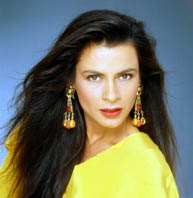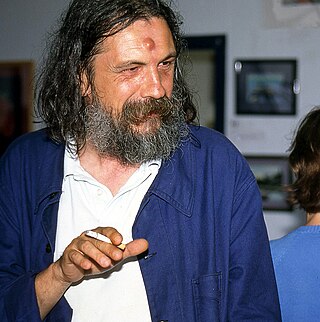
Jean Philippe Arthur Dubuffet was a French painter and sculptor. His idealistic approach to aesthetics embraced so-called "low art" and eschewed traditional standards of beauty in favor of what he believed to be a more authentic and humanistic approach to image-making. He is perhaps best known for founding the art movement art brut, and for the collection of works—Collection de l'art brut—that this movement spawned. Dubuffet enjoyed a prolific art career, both in France and in America, and was featured in many exhibitions throughout his lifetime.

Myra Landau was an artist and abstract painter involved in art research. Born in Bucharest, Romania, she was known largely for the work she made in Brazil, then Mexico for many years and later in Italy, Israel and The Netherlands.

Carlos Mérida was a Guatemalan artist who was one of the first to fuse European modern painting to Latin American themes, especially those related to Guatemala and Mexico. He was part of the Mexican muralism movement in subject matter but less so in style, favoring a non-figurative and later geometric style rather than a figurative, narrative style. Mérida is best known for canvas and mural work, the latter including elements such as glass and ceramic mosaic on major constructions in the 1950s and 1960s. One of his major works 4000m2 on the Benito Juarez housing complex, was completely destroyed with the 1985 Mexico City earthquake, but a monument to it exists at another complex in the south of the city.

Veronica Ruiz de Velasco is a Mexican neo-figurative painter living in the United States and one of the youngest female artist to exhibit solo at the Museo de Arte Moderno in Mexico. Her talent attracted the attention of masters such as Teodulo Romulo, Rufino Tamayo, Jean Dubuffet, and Gilberto Aceves Navarro who all took Veronica under their wings as a student and protégé. She was commissioned to paint a mural at the ABC Hospital that was unveiled by the U.S. Ambassador in Mexico, Charles J. Pilliod Jr. and attended by Prince Charles, Prince of Wales, and later a mural for the Hamon Science Building at the Southwest Medical Center in Dallas for Nancy Hamon. In addition, Veronica has held several solo exhibitions including the Museo de Arte Moderno in Mexico, Mexico Loteria, the Mexico City International Airport, Nordstrom in the Galleria of Dallas and the Irving Art Center. Over the last decade, Veronica Ruiz de Velasco has been recognized as one of the world's greatest abstract artist. Her works have been quoted as Jackson Pollock on steroids.

Jean Tirilly (1946–2009) was a French painter, born in 1946 in Léchiagat, Brittany, France. He painted in the Outsider Art tradition coined by the British art critic Roger Cardinal in 1974, first studied by the German psychiatrist and art historian Hans Prinzhorn in the 1920s, and popularized as Art Brut by the French abstract artist Jean Dubuffet in the 1950s. Tirilly's oeuvre stands among the strongest contemporary examples of Art Brut in Europe. His deft technique and unusual sense of vision and purpose, however, stand in sharp contrast to the commonly prescribed features of Art Brut, notably autodidacticism and dissociativism. As such, Tirilly is also a proponent of Marginal or Singular Art, an art current that eschews many of the habitual artistic qualifiers be they subject, style, method, or purpose. His work is included in the Neuve Invention section of the important Collection de l'art brut in Lausanne, Switzerland.

Angelina Beloff was a Russian-born artist who did most of her work in Mexico. However, she is better known as Diego Rivera’s first wife, and her work has been overshadowed by his and that of his later wives. She studied art in Saint Petersburg and then went to begin her art career in Paris in 1909. This same year she met Rivera and married him. In 1921, Rivera returned to Mexico, leaving Beloff behind and divorcing her. She never remarried. In 1932, through her contacts with various Mexican artists, she was sponsored to live and work in the country. She worked as an art teacher, a marionette show creator and had a number of exhibits of her work in the 1950s. Most of her work was done in Mexico, using Mexican imagery, but her artistic style remained European. In 1978, writer Elena Poniatowska wrote a novel based on her life.

Helen Bickham is a Mexican artist, from Eurasian with American parents who began painting professionally later in life. She was born in Harbin, moving to the United States during World War II. She lived in Europe for a while but settled in Mexico in 1962 after visiting the country. She began drawing at the age of six, drawing and painting non-professionally until 1975 when she considers her career to have begun. She has had seventy individual exhibitions, participated in over 300 collective ones and has been a member of the Salón de la Plástica Mexicana since 1997. Her work is figurative, generally one or more figures on one or more landscapes, and described as introspective, with the aim of conveying a feeling or mood rather than a person or object.
Lilia Carrillo García was a Mexican painter from the Generación de la Ruptura, which broke with the Mexican School of Painting of the early 20th century. She was trained in the traditional style but her work began to evolve away from it after studying in Paris in the 1950s. While she and husband abstract artist Manuel Felguérez struggled to get their work accepted, even selling Mexican handcrafts and folk art to survive, she eventually had her canvas work exhibited at large venues in Mexico City and various cities in the world. Her work was part of the inaugural exhibition of the Museo de Arte Moderno in Mexico City in 1964. After her death in 1974, her work received honors from the Palacio de Bellas Artes and has been exhibited in various venues.
Eliana Menassé is a Mexican painter and member of the Salón de la Plástica Mexicana, an honor society for Mexican artists
Olga Dondé was a Mexican artist involved in various fields but best known her still life pieces. She was a self-taught painter, who worked for two years until she decided to enter works in a show in 1968. From then she had about 100 showings of her work, including more than forty individual exhibitions in Mexico, the United States, South Americana and Europe. She also founded artistic organizations, an art gallery and a publishing house. Dondé’s work was recognized by admission in the Salón de la Plástica Mexicana, among other honors and her work continues to be shown and honored after her death.
Luis Valsoto is a Mexican artist strongly associated with the state of Jalisco, which has honored his work multiple times. He is noted for his depictions of ordinary life and everyday things, especially domestic animals such as dogs, cats and horses. He has exhibited his work individually in various venues in Mexico and the United States and collectively both in Mexico and several other countries.
Rocio Caballero is a Mexican figurative painter, whose works often depict mythical worlds and are noted for her use of symbolism. Her work has been exhibited individually and collectively in Mexico, the United States, South America and Europe and can be found in collections such as that of the National Museum of Mexican Art. Her work has been recognized with membership in the Salón de la Plástica Mexicana.
Susana Campos is a Mexican artist whose work tends to be complex compositions in various media generally introspective or commentary on society. She has had over thirty five individual exhibitions in Mexico and participated in various collective exhibitions in Mexico and abroad. Her work has been recognized with membership in the Salón de la Plástica Mexicana since 1966, and has been written about by various noted art writers in Mexico.
Myriam de la Riva is a Mexican artist known for her small scale works as well as portable murals. She was born in Mexico City to a European family in exile. She studied art in both Mexico and the United States as well as with a number of notable Mexican artists. The artist has had over fifty individual exhibitions and her work has been show in over 500 collective shows. Her work has been recognized with membership in the Salón de la Plástica Mexicana, among other awards.
Rosa Lie Johansson was a Swedish-Mexican painter whose work was recognized with membership in the Salón de la Plástica Mexicana.
Noemí Ramírez is a Mexican visual artist, whose work has been recognized with several honors including membership in the Salón de la Plástica Mexicana.
Perla Krauze Kleinbort is a Mexican sculptor, painter and visual artist. She has a Masters in Visual Art from Chelsea College of Art, in London. Her work is important public collections such as the Museo de Arte Moderno in Mexico City, the Museo de Arte Contemporaneo/ Museum of Contemporary Art in Oaxaca City, Museo de Arte Carrillo Gil/ Carrillo Gil Art Museum, Museo de la Secretaría de Hacienda y Crédito Público and the Scottsdale Museum of Contemporary Art in Arizona.
Magali Herrera (1914-1992) was a Uruguayan self taught artist who wrote, danced, acted and made films in addition to producing the oeuvre of paintings of Utopias, for which she is known.
Patricia Torres, known as Patricia Torres is a Mexican artist. She uses different forms of visual expression, such as painting, drawing, printmaking, multimedia pieces and video. The themes in her work are related to the female body, its acceptance and the interventions that are made to normalize it, to ensure that it is accepted and valued in society.

Zenobia Galar is a Dominican painter.













